Do children need to get a bunch of toys to be better equipped to learn and grow?
Not necessarily! In fact, when they have fewer toys in their environment, they spend more time with these toys, focusing on and playing more creatively with them (Dauch, C., Imwalle, M., Ocasio, B., & Metz, A. E.,2018) .
This holiday season you can trade out the 50 toys (soon-to-be living room decor) for a few mindfully selected toys that speak to your child’s interests and support their developmental interest and growth across several domains (social-emotional, gross motor, etc).
Below we offer some ideas and examples divided by age to give you an idea of what to consider this gifting season.
Support local businesses! Most toys suggested here can be purchased locally at Bringing Up Baby Boston in South Boston, Tadpole South End and Magic beans in Cambridge and Wellesley, MA
Birth to 6 Months
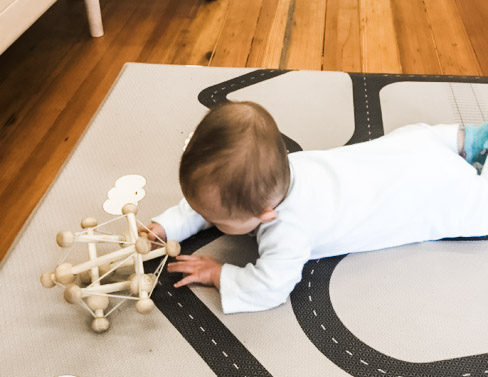
What’s going on with my baby?
- Your baby’s vision is improving
- Your baby will start grasping objects
- Your baby explores the world with their mouth
- Tummy time is important for core body development, respiratory regulation, and spatial awareness
What characteristics should I look for in toys?
- Toys that are easy to grasp
- Toys that are colorful or high contrast
- Toys that make gentle noises when shaken or easy-to-grab musical instruments
- Toys with different textures and shapes
- Baby-safe mirrors
- Fabric, board or plastic books
| The Rainbow Skwish is easy to grasp, with a soft rattle! | Hape Rainbow Rattle. Flips out and has a gentle sound: an engaging manipulative for our youngest! | Fabric books with pleasant pictures and contrasting colors. |
6 to 12 Months
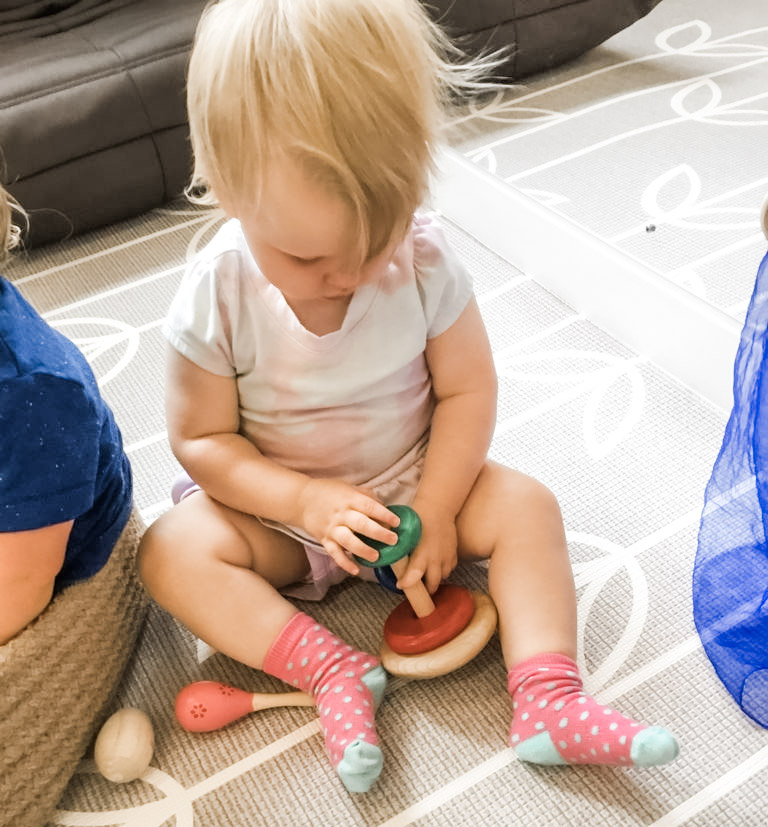
What’s going on with my baby?
- They love repetition as it helps them learn cause and effect
- They love filling and dumping
- They love playing peekaboo
- They enjoy nursery rhymes and songs
- They are perfecting pincer grasp (used to pick up small objects)
- They are developing gross motor skills (rolling, crawling and cruising)
What characteristics should I look for in toys?
- Safe baby-size blocks
- Fabric, board or plastic books
- Simple puzzles with knobs
- Ring stack or stacking cups
- Push/pull toys like balls and chunky cars
HABA Baby’s First Basic Block Set | Janod Lapin Stackable Roly-Poly Rabbit | Kaplan Early Learning Company Baby Touch & Feel Board Book Set |
Hape Little Autos | Play Toys Roller Rattle | Knob Wooden Puzzles |
12- 24 Months
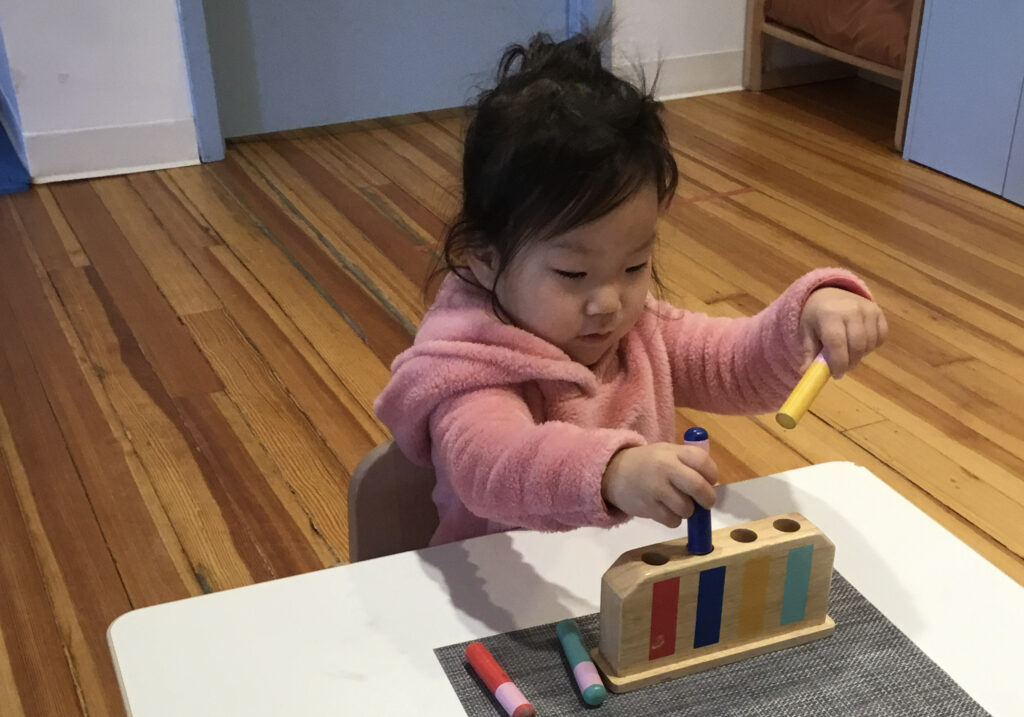
What’s going on with my baby?
- They are learning how objects are used together
- They are making connections between objects and real-life
- They are starting to enjoy side-by-side play (being near peers)
- They are beginning to use spoken language and growing their vocabulary
- They are building strength, balance, and coordination in their movement
What characteristics should I look for in toys?
- Nesting cups/rings or shape-sorters
- Toy cars/trains
- Pop-beads or chunky interlocking plastic blocks
- Art activities
- Practical life play like play phones
- Sand/water play
- Board books
Melissa & Doug Shape Sorting Cube | Janod Multi cars truck | DO-A-DOT 6 PACK PRIMARY |
Hape Duck Push Pal | Magna-Tiles Clear Colors 32-piece Set | Natural Play Book Tower: Little Learning Books |
24- 36 Months
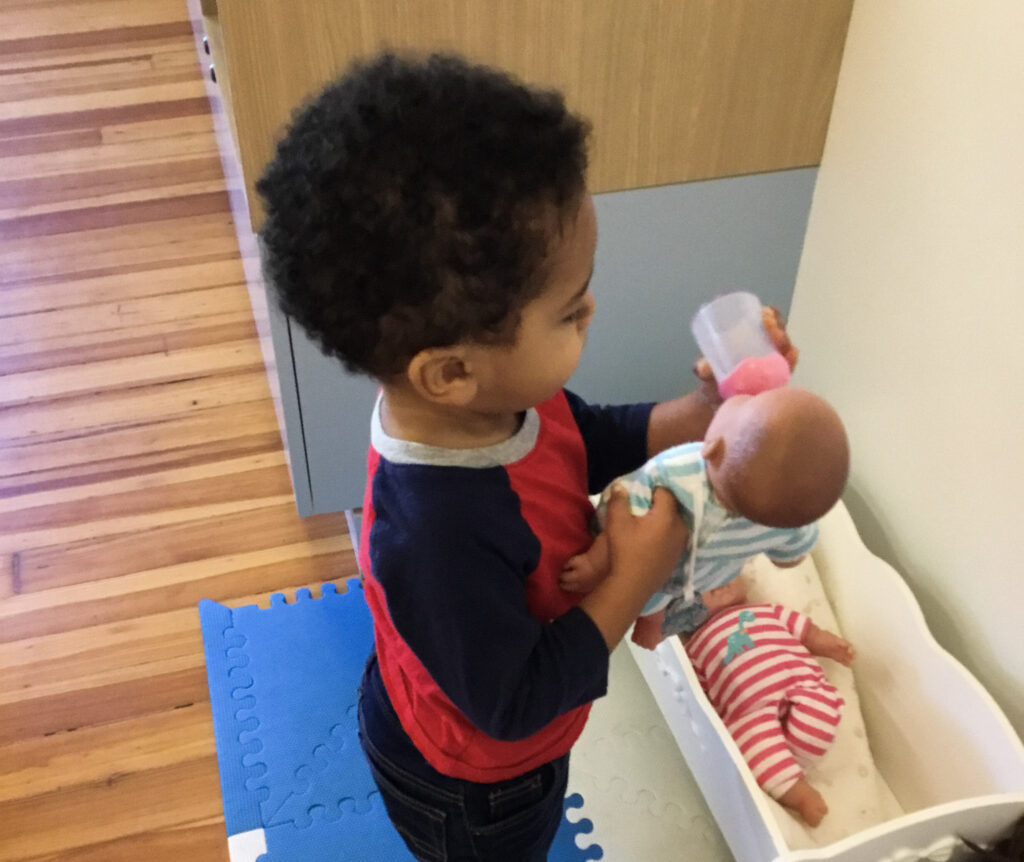
What’s going on with my toddler?
- They enjoy partaking in pretend play
- They are learning to problem solve
- Their fine motor skills continue to develop
- They continue to grow social skills: learning to share, take turns, express emotions
What characteristics should I look for in toys?
- Practical life toys (buses/cars, toy people, kitchen items, stuffed dolls/animals)
- Sorting toys
- Memory and matching games
- Pull-toys, stringing beads, and pop-beads
- Washable crayons and markers
- Open-ended toys (toys that can be used in multiple ways and usually don’t have rules on how to use them).
Babies | Rock crayons : great for young children developing and strengthening the pincer grip needed to control a pencil. | |
Blocks | Pretend cooking | Pretend food |
Brio Train sets | Lots of Feelings book by Shelley Rotner’s | Janod Doctor’s Suitcase |
3-6 years
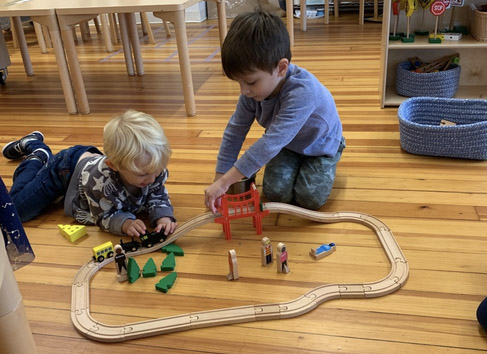
What’s going on with my child?
- Practicing and learning socialization skills
- More complex pretend play
- Like to participate in practical life skills
- Fine motor skills are solidifying
- Balance and coordination is becoming better
- Taking more interest in written words
- Vocabulary is flourishing
What characteristics should I look for in toys?
- Toys to create with like paints, child-sized scissors, modeling clay and tools
- Toys which encourage exploration and reflect practical life
- Open-ended toys which stimulate creativity and imagination
- Games which allow for taking turns and sharing
- Toys that support balance and coordination, and gross motor skills in general as kids this age are very active!
- Books with riddles
Hape Tea Set for Two | Melissa & Doug Scoop & Serve Ice Cream Counter | Plan toy Balancing Tree |
Animal Puppets | Dr. Seuss’s Beginner Book Collection | Build A Fort Kit |
Step-a-Logs | Modeling Dough | Hape Balance Wonder Balance Bike |
As you take on the task of finding toys that will support growth and development (and are fun!) for your child, we remind you that regardless of age, their favorite toy will always be you!
As the year comes to an end, we may be reflecting on what we have and hold most dear to us. What better way to cherish our children, than being present with them and nurturing your relationship?
We cherish your presence in our lives and are one phone call or click away, here whenever you need us!
Ethos is a new mindset and model for child care and early education for children aged 6 weeks to 5 years in the South Boston, MA Area. We pride ourselves on our dedication to serving our students and families in ways that are research-driven and nurturing to who they are and can become. Request more information online here!
Till Next Post,
Aleezeh Makani
Ethos Early Learning Center Educator
The list below contributed to the suggestions above and also offer additional ideas and resources for you and your family:
– 9–12 Months: Your Baby’s Development. (2016, February 6). Retrieved November 23, 2020, from https://www.zerotothree.org/resources/
– 3–6 Months: Your Baby’s Development. (2016, February 6). Retrieved November 23, 2020, from https://www.zerotothree.org/resources/
– 6–9 Months: Your Baby’s Development. (2016, February 6). Retrieved November 23, 2020, from https://www.zerotothree.org/resources/
– Center on the Developing Child (2007). The Science of Early Childhood Development (InBrief). Retrieved from www.developingchild.harvard.edu.
– Dauch, C., Imwalle, M., Ocasio, B., & Metz, A. E. (2018). The influence of the number of toys in the environment on toddlers’ play. Infant Behavior and Development, 50, 78-87.
– Guyton, G. (2011). Using toys to support infant-toddler learning and development.
– N. (n.d.). Good Toys for young children by age and stage. Retrieved December 09, 2020, from https://www.naeyc.org/resources/topics/play/toys
– Zero To Three. (2016, February 9). Supporting Brain Development From 18 to 24 Months. Retrieved November 30, 2020, from https://www.zerotothree.org/resources/101-supporting-brain-development-from-18-to-24-months
Trawick-Smith, J., Wolff, J., Koschel, M., & Vallarelli, J. (2014). Which toys promote high-quality play? Reflections on the five-year anniversary of the TIMPANI study. YC Young Children, 69(2), 40.